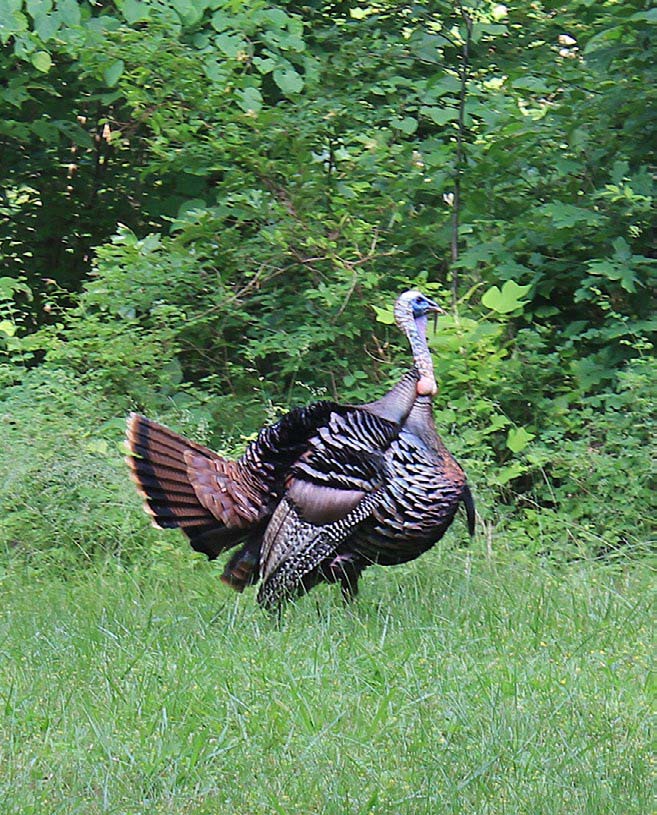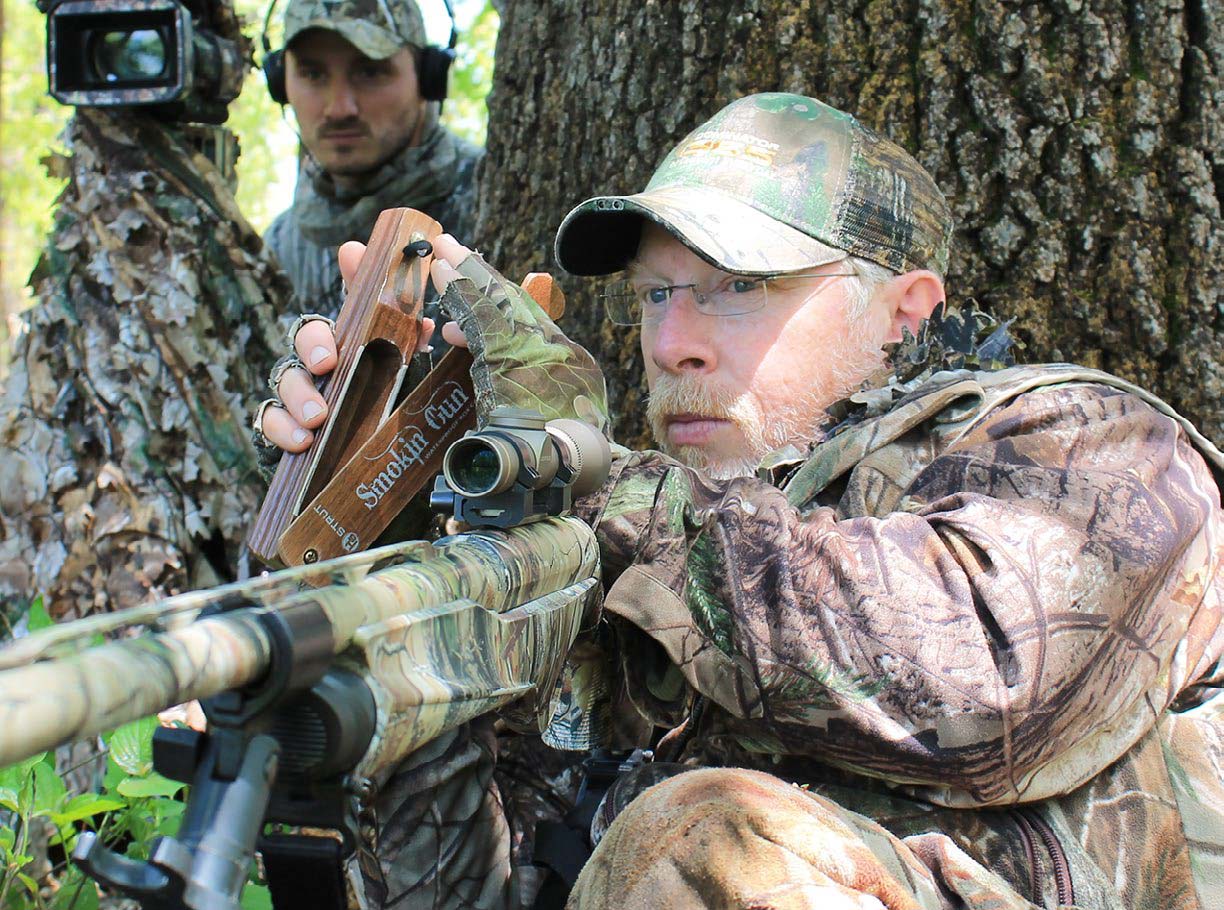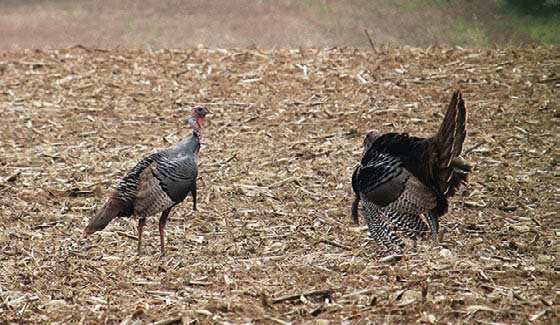A look at turkey hunting facts that can benefit turkey hunters
There is much we don’t know about within the wide world of wild turkeys. There are many facts and strong opinions that we do know of though, and the following present some of those. Read along as we cover wild turkey facts you need to know.
Turkeys Have Great Eyesight
Eyesight is a turkey’s primary defense sense. They can visualize and process data very quickly, even faster than humans do. With eyes located on the sides of their heads, turkeys have 360-degree vision with just a slight turn of the head. They have monocular vision, so their depth perception isn’t as good as ours, but most of their field of view is always in focus. That means it is easy for them to pick up slight movements. Plus, they are able to see most of the colors that we do, as well as ultraviolet (UV) light. That includes the UV found in most modern clothing.
Turkeys Have Solid Hearing
In addition to having great eyesight, turkeys can also hear quite well. While their hearing isn’t much more acute than ours, it is greater. Turkeys also seem to hear lower frequencies and can do that from greater distances than we can, too. They are also very adept at picking up sounds unnatural to their environment and vacating an area as quickly as a result.
Turkeys Can Smell (Slightly)
Wild turkeys are not Whitetails in the olfactory department, but they do have a slight sense of smell. This likely hasn’t ever busted a hunt, but it is interesting to know that these birds do have the ability to deploy the sniffer.
Hens Can Strut and Gobble
While most hunters don’t realize it, it isn’t just toms and jakes that gobble and strut. Yes, wild turkey hens can sound off with a shallow gobble. They can also puff up those tail feathers. While these actions are both quite rare, when they happen, they are generally aggressive displays of dominance toward other hens or even toward predators.
Turkey Droppings Identify the Birds
Hunters can determine whether a male or female turkey left behind the scat. Unless disrupted in some manner, male birds have J- or L-shaped droppings. In contrast, female turkeys have spiral, popcorn-shaped poop.
Body Language Matters
One of the biggest things for turkey hunters to pay attention to is turkey body language. Non-verbal expressions can clue hunters in as to what turkeys are thinking or even what they’re about to do. Top things to pay attention to include head coloration, snood length, periscoping head, stretching, big wing flaps, quick wing flicks, tail flares, strutting, spinning and walking off.
Most Male Turkeys Die Young, Some Die Old
Most wild male turkeys die before the age of one. Of those that surpass that threshold, they rarely survive past two years. This is especially true in states with high predation levels and where hunters are allowed to shoot jakes. That said, it’s different where jakes are restricted (or mostly restricted) from harvest. Jeremy Wood, an Arkansas Game & Fish Commission turkey program coordinator, says that under the latter circumstances, over 90% of jakes reach the two-year-old age class.
So, two-year-old turkeys tend to get mowed down by the end of their second spring season. But if they reach three years old, their odds go up. “Two-year-old gobbler survival is estimated at 33%,” Wood says. “At three years of age, survival jumps to 50%. This suggests that when you have multiple years of poor reproduction, most of the young birds are being harvested as soon as they’re legal; those that do survive tend to be older birds,” he adds. “It is not uncommon from band reports to have birds shot at four, five and six-plus years old.”
While most turkeys die within the first few years of life, wild birds can have lifespans of up to 10 years. Generally though, they don’t reach these ages, especially in heavily hunted areas and where predators abound.
Decreased Gobbling Is Due to Fewer Birds
Turkey hunters often attribute late-season decreases in gobbling to an ending breeding cycle and uninterested gobblers. But it’s much simpler than that. Some turkeys are dead, and there aren’t as many remaining to gobble. “Throughout all our studies monitoring gobbling activity, the number one driver of reductions in gobbles heard on the landscape is the removal of males via hunting on the landscape,” says Bret Collier, a Louisiana State University wildlife biologist who focuses on wild turkeys. “That means there are fewer gobbles because there are fewer birds left to gobble.”
Plus, some turkeys are just harder to hunt. “I think there are some individual birds that are just harder to kill,” he says. “We have seen GPS-tagged males stay within relatively small areas near where hunters are regularly hunting, and they are never harvested.”
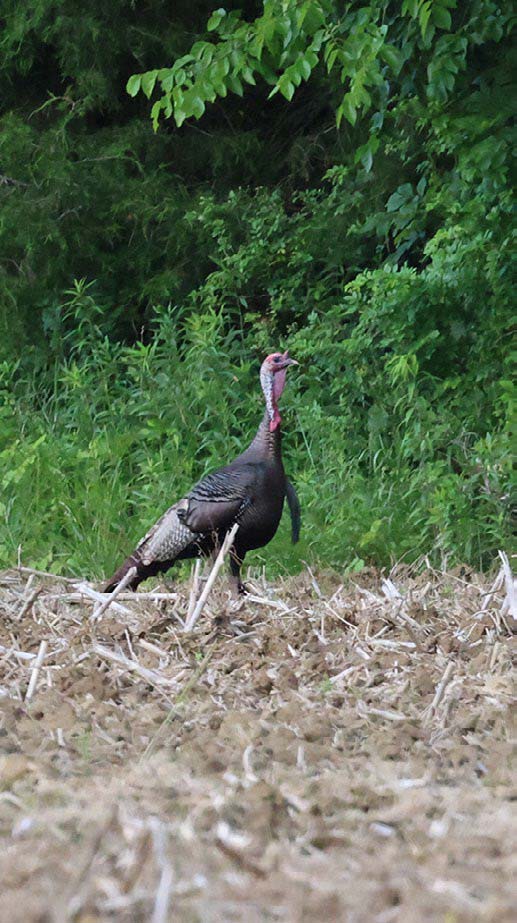
Turkeys Quit Talking for Good Reasons
There are numerous reasons why gobblers quit gobbling. First, it’s possible that hens intercepted it, and the gig is up. When this happens, try to fire up that boss hen and get her good and worked up. Oftentimes, she’ll come looking for you.
Secondly, it’s possible the bird just got whipped. I’ve had a gobbler coming to the call, only to meet up with another tom. Then a fight ensued and both completely forgot about my hen talk. When this happens, regroup and try to be less aggressive with decoys (i.e.: no strutter or jake decoys). Third, you called too much and turned off the bird. Or, you called too loudly. So, the fix is to wait a little while and try again. Other reasons include these: the temperature warmed up and the turkey quit gobbling. He didn’t like something he saw or heard. A predator intervened. Or the turkey quit talking because it committed to the call and is on the way in.
Turkeys Avoid Setups for Good Reasons
There are numerous potential reasons why turkeys don’t come to a given setup. Some of these are the same as the reasons above for why a turkey quits gobbling. But there are others.
One is that you’re trying to reverse nature’s order. Generally, hens go to the gobbling tom, and not vice versa. So, trying to call a gobbler to you is the opposite of what typically occurs. Another reason is that your call isn’t right. Perhaps the cadence isn’t what it should be. Maybe the rhythm is off. Maybe the bird has heard your calling for several hunts already and isn’t buying it. Perhaps the blind calling is too soft or too loud. Or maybe you’re using the wrong vocalizations and saying the wrong things. Whatever the case, the calling is the reasoning.
Other reasons might be that the bird just wants to eat, you’re too far from the turkey, an obstacle is in his way, there are no visuals (decoys) to back up the calling, you’re moving too much, or you aren’t using one of the best turkey calls out there.
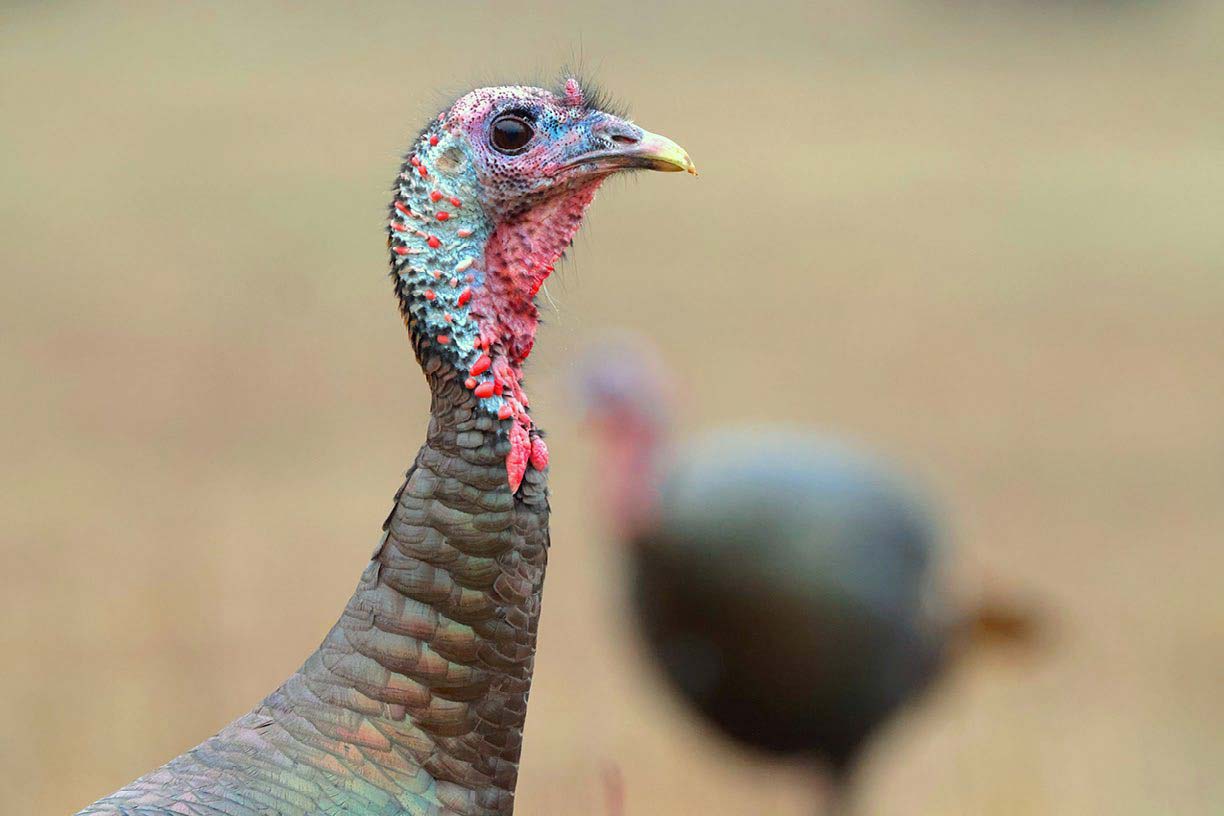
Promoting a Good Nesting Environment Boosts Turkey Populations
There are numerous things turkey hunters and land managers can do to increase turkey numbers on the landscape. These include deploying predator management tactics; maintaining the right ratio of cover to open areas; offering diverse habitat features; creating large blocks of nesting cover (and not narrow strips that become killing sprees for predators). You can also remove valueless plants; plant native grasses; optimize early successional cover; conduct quality timber stand improvement (TSI) work, and safely implement prescribed fire. Additionally, you might offer good food and water sources next to nesting and escape cover and not use pesticides (young poults rely on insects).
No, Southern Turkeys Aren’t Harder to Kill
It’s long been touted that southern turkeys are more difficult to kill. But according to available research, that might not be true. “I don’t have any data that shows wild turkeys in the southern U.S. are any harder to kill than a turkey anywhere else,” Collier says. “My anecdotal opinion is they are not. The rule I would say is that southeastern turkeys are not harder to kill, on average, but occasionally, you get one that just drives you nuts.”
More Turkey Fast Facts
- Turkeys are believed to have been named after the country, Turkey, by European settlers. It’s believed the wild turkey here reminded them of a bird that was native to Turkey.
- There are six subspecies of wild turkeys: the Eastern, Gould’s, Merriam’s, Osceola, Ocellated, and Rio Grande.
- Jakes are sub-adult males; jennies are sub-adult females.
- Approximately 10% of adult wild turkey hens grow beards.
- Adult male turkeys have black and bronze feathers. Adult female turkeys have brown feathers.
- Male turkeys have a longer middle toe, while female turkey toes are all of the same lengths.
- Male wild turkeys can weigh up to 30 pounds, but usually top out around 25 pounds.
- Female wild turkeys can weigh up to 20 pounds, but usually top out at 10 to 15 pounds.
- Male turkeys stand about 2½ to 3 feet tall. Females stand about 1½ to 2 feet tall.
- Male wild turkeys have a wingspan of about 50 to 55 inches.
- Mature wild turkeys have approximately 18 tail feathers and 5,500 total features.
- Wild turkeys can run up to 20 miles per hour.
- Wild turkeys can fly up to 50 miles per hour.
- Wild turkeys can fly for up to approximately one mile.
- Spurs are more indicative of a turkey’s age than its beard.
- Hens lay approximately 10 to 15 eggs and incubate these for about 28 days.
Iconic Figures in Wild Turkey Conservation
Many individuals have accomplished much for the conservation of wild turkeys. The following are just a few of these great hunter-conservationists. If you don’t recognize the name, do some research. You’ll be glad you did.
- Aldo Leopold: The Godfather
- Brenda Valentine: The Huntress
- David Hale: The Mountain Man
- George Bird Grinnell: The Conservation Guru
- Harold Knight: The Other Mountain Man
- Herman Holbrook: The Canon Man
- James Earl Kennamer: The Biology Man
- Johnny Morris: The Big Boss
- Lovett Williams: The Turkey Whisperer
- Michael Waddell: The Funny Man
- Mike Chamberlain: The Gobbler Doctor
- Ray Eye: The Radio Connoisseur
- Rob Keck: The Boss Man
- Steven Rinella: The Netflix Man
- Teddy Roosevelt: The Father of Modern Conservation
- Tom Kelly: The Wordsmith
- Tom Rogers: The Founder of the NWTF
- Will Primos: The Call-Maker Man
Pro Turkey Calling Tips
Professional turkey hunters get to spend a lot of time in the woods chasing spring thunder. Here are some top tips from top turkey hunters.
- Aaron Warbritton, The Hunting Public: Listen to real turkeys, not turkey callers.
- Anthony Virga, Professional Turkey Caller: Use a variety of turkey calls.
- Art Helin, Own the Season TV: Carry waterproof turkey calls.
- Brenda Valentine, Professional Hunter: Sound like the hens on that given day.
- Cody Kelley, Backwoods Life: Have more patience than the tom you’re calling to.
- Eddie Salter, The Turkey Man: Read your target turkey’s body language and mood.
- Jace Bauserman, Outdoor Writer: Pick a vocal fight with the boss hen.
- Jordan Summit, Strutt Commander: Use soft calling at first light.
- Josh Carney, Son of the South: Learn from an experienced mentor.
- Josh Dahlke, HuntStand: Find unpressured birds.
- Mark Drury, Drury Outdoors: Find the calls you can run the best.
- Nate Hosie, HeadHunters TV: Be as realistic as possible.
- Randy Birdsong, HeadHunters TV: Start with soft calls and slowly increase excitement.
- Scott Ellis, Professional Turkey Caller/Hunt Quest: Be proficient on multiple calls.
More Turkey Tactical Advice to Bank
Certain turkey hunting tactics have minimal effect, and some have significant effect. Here are some of the latter.
Don’t Overlook Small Properties
While it’s great to have access to large tracts of land, don’t overlook smaller properties. Turkeys often inhabit these areas, too. Certain boxes should be checked, though. Some of these include being in the right area with good habitat; land managed with a purpose; offering unique food sources; and/or having good roost trees. If these elements are present, consider spending time scouting the birds, establishing ground blinds in key areas, using good entry and exit paths that don’t spook turkeys, choosing setups wisely, hunting when birds are on the property, and being appropriately aggressive and patient.
Plant Good Food Plots
Food plots aren’t just for deer. These are great food source additions for gobblers, hens, jakes and jennies, too. Solid plant species for birds include alfalfa, buckwheat, cereal rye, chufa, clover, lespedeza, millet, sorghum, oats, and wheat. Also, consider planting certain soft mast trees, too, including apple, crab apple, mulberry, pear, persimmon and plum. Hard mast trees of importance are beech, chestnut, hickory, red oak, white oak, etc.
Use Key Locator Calls
There are some locator calls that you’ve likely already implemented, including crow, owl and cutting hen calls. Then, there are calls that you might not have used, such as coyote, duck (see best duck hunting waders), goose and pileated woodpecker. Finally, certain calls are rarely used but sometimes effective, like a rock on a guard rail, a truck door slam, and a hawk-like loud scream.
Pattern Your Bird
There are numerous ways to pattern a wild turkey. First, start with the terrain, as it influences where turkeys roost, walk and feed. Search for sign, such as wing feathers, droppings, tracks, dust bowls, strut marks and more. Spend time scouting, including glassing from afar and posting trail cameras. And certainly, pay attention to the hens, since the toms will be following them for most of the season.
Use Trail Cameras Correctly
Trail cameras can be excellent tools for turkey hunters. That means starting with good trail camera locations. Some of these include fly-up zones, fly-down zones, ag fields, food plots, grassy openings, transition areas, travel routes and pinch points.
Use the Terrain to Your Favor
Certain terrain features tend to benefit hunters. Some of the ones that offer even greater advantages include ag fields, ridges, points, benches, flats, pinch-points, hollows, bottomlands, draws, hidden fields, pastures and around edge (nesting) cover. Turkeys spend a lot of time in these areas.
Don’t Make Decoy Mistakes
Hunters can make many mistakes using decoys. Blunders to avoid are:
1) Settings decoys in locations they aren’t visible.
2) Positioning decoys too close (dangerous) or too far (leads to hung-up turkeys out of range).
3) Facing decoys the wrong way since it’s important to make the setup look natural.
4) Using turkey vocalizations that don’t match the decoy spread.
5) Using decoys that aren’t realistic.
6) Using decoy spread types that don’t match the current events (such as phase of the breeding cycle).
Take a High-Odds Road Trip
Certain turkey-hunting states are better DIY destinations than others. In general, and unless you already have an inroad to a great turkey hunting property, these tend to produce higher odds of success. Honorable mention states include California, Maine, Missouri, and Pennsylvania. The top 10 include:
10) Texas
9) Mississippi
8) Georgia
7) Kentucky
6) Florida
5) Alabama
4) Tennessee
3) Kansas
2) Nebraska
1) Wisconsin
Use Special Tactics for Public Lands
There are numerous things hunters can do to increase their odds of hunting success on public ground. Some of these include:
1) Finding pockets of land that other hunters overlook.
2) Getting there very early and parking near the hunting spot so other ethical hunters won’t try to hunt the same spot.
3) Roosting a turkey and being there very early the next morning.
4) Hunting from mid-morning on after other hunters have left the woods.
5) Getting closer to the roost tree.
6) Not keeping a bird gobbling on the limb, as that will attract other public-land hunters.
7) Changing up your calls, and using various ones, so that it sounds like multiple birds.
8) Having multiple game plans, as the first ones rarely work out.
Per our affiliate disclosure, we may earn revenue from the products available on this page. To learn more about how we test gear, click here.






